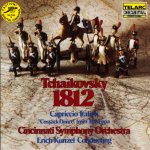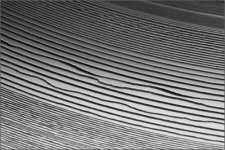The rumor is the digital recording of the 1812 Overture damaged speakers because of the new incredible dynamic range. Did this actually happen to anyone or has it grown to urban legend status? Your speakers had to have been on their last legs or the cheapest speakers in existence to fly apart from a loud passage. I say it was great marketing.
[FONT=Times New Roman, Times, serif]
[/FONT]Telarc's recording stunned listeners as cannon were recorded at a very high level compared with the music. The impact was, indeed, remarkable. Warnings on all LP and CD issues advised listeners to be careful of playback levels so as not to damage equipment, particularly speakers.
Attachments
Unless proven otherwise I´d adscribe it to the Urban Legend section.
No matter what you have on record, you need a POWERFUL amplifier, WAY above what speakers can stand, to damage speakers.
Combine that to a poorly designed cabinet, which leaves speakers undamped or uncoupled, and maybe voice coils will smash against the backplate.
My point being that there must be some physical reason for damage; speakers know nothing about "music", just voltage, current, (which together mean power), and excursion.
FWIW a Slapper/Thumber Bass player sends such "non Musical" high power transients for hours on end and amp/speakers stand them.
Think about the peak voltages and frequencies involved in a heavy thumb hammering a Bass Guitar thick string against the pickup or fretboard and you are close to what a *recorded* cannon shot can be.
The key word being *recorded*, which means one way or another it fit inside the recording media limitations.
An actual cannon shot, ever a rifle or pistol one, simply can not fit into a recording, what we have is a poor version with the microphone well away from the source, *or* a heavily clipped one, so it is considerably tamed.
Just look at the groove, it´s larger than anything else there, but definitely it is NOT 40/45dB above loudest symphonic Music, no way.
Didn´t get cannon shot SPL (in bit of a hurry now) but here you have much weaker Rifle/Pistol/Shotgun SPL
Many around 160/165dB SPL, cannon can only be higher.
https://www.caohc.org/UserFiles/file/Shot of Prevention extra handout.pdf
Such extreme dynamic range, more than 40dB ABOVE MAXIMUM simply does not fit.
No matter what you have on record, you need a POWERFUL amplifier, WAY above what speakers can stand, to damage speakers.
Combine that to a poorly designed cabinet, which leaves speakers undamped or uncoupled, and maybe voice coils will smash against the backplate.
My point being that there must be some physical reason for damage; speakers know nothing about "music", just voltage, current, (which together mean power), and excursion.
FWIW a Slapper/Thumber Bass player sends such "non Musical" high power transients for hours on end and amp/speakers stand them.
Think about the peak voltages and frequencies involved in a heavy thumb hammering a Bass Guitar thick string against the pickup or fretboard and you are close to what a *recorded* cannon shot can be.
The key word being *recorded*, which means one way or another it fit inside the recording media limitations.
An actual cannon shot, ever a rifle or pistol one, simply can not fit into a recording, what we have is a poor version with the microphone well away from the source, *or* a heavily clipped one, so it is considerably tamed.
Just look at the groove, it´s larger than anything else there, but definitely it is NOT 40/45dB above loudest symphonic Music, no way.
Didn´t get cannon shot SPL (in bit of a hurry now) but here you have much weaker Rifle/Pistol/Shotgun SPL
Many around 160/165dB SPL, cannon can only be higher.
https://www.caohc.org/UserFiles/file/Shot of Prevention extra handout.pdf
Such extreme dynamic range, more than 40dB ABOVE MAXIMUM simply does not fit.
It damaged my friend’s Snell type A speakers, the amps were a pair of bridged Apt Holman amps, the blast torn out the voice coil wires. I was there when it happened.
Good thing he wasn't watching movies on his home theater system using that amp/speakers. Any war movie would have killed it.
Why is that? Todays music is compressed to levels that every low quality consumer El Cheapo System can play it without any problems. They are manipulating the signals further, so on cheap speakers consumer grade the music should sound full and with deep bass.
I can hear the differences on my system very clearly when records are enhanced, compressed or modified in a way they sound better (in my system often more worse) in cheap consumer audios. They mix everything with their multi miking and multi channel mixers which are in fact a gas chamber for real music. Everything that comes out of them is literally dead. Robbed its presence, enhance in many ways, compressed to death.
I can hear the differences on my system very clearly when records are enhanced, compressed or modified in a way they sound better (in my system often more worse) in cheap consumer audios. They mix everything with their multi miking and multi channel mixers which are in fact a gas chamber for real music. Everything that comes out of them is literally dead. Robbed its presence, enhance in many ways, compressed to death.
No matter what you have on record, you need a POWERFUL amplifier, WAY above what speakers can stand, to damage speakers.
I folded the cone on a Beyma 15P1200Nd, and didn't even hit half of the AES power rating. That was in a ported box, though.
I'd be very hesitant to bring my current amplifier (Cambridge CXA80) to full bore at very-low-frequencies with my current midbass speakers (Seas H1252, sealed box), too - the predicted excursion is well in excess of Xmax.
Chris
According to 'Stereophile' (edited): "The dynamic range on this disc is only about 45dB between the softest and the loudest (bass drum) musical passages which is roughly 15dB more dynamic range than is on the statistical average of symphonic LPs, and 5dB more than on any audiophile disc we have encountered! When we consider that a 10dB change sounds to our ears like a halving or doubling of volume, it is no wonder that this latest from Telarc sounds like such a blockbuster."
Telarc themselves claimed that the cannon shots (which were recorded separately and then mixed into the orchestral recording) damaged their own equipment, but I suppose they would, wouldn't they? 😉
Telarc themselves claimed that the cannon shots (which were recorded separately and then mixed into the orchestral recording) damaged their own equipment, but I suppose they would, wouldn't they? 😉
This is not popular music.... usually recordings meant to reproduce some reality like soundstage.Why is that? Todays music is compressed to levels that every low quality consumer El Cheapo System can play it without any problems.
Never killed my speakers ... and I played it loud on TL's! Worst case some clipping in the amplifier, no problem with the speakers.
I can imagine that small speakers are incapable to reproduce such recordings well, since a lot of energy is in the lowest octaves.
a late friend visiting was passed out in bed - I thought it would be funny to wake him with the finale - that recording destroyed two K33 woofers in my Klipschorns which were only about 8 foot from him - he didn't wake ! (the power of wine) It may have been due to the Belles amplifier rated at only 70 watts per channel having severe clipping. Maybe another 6dB of power and the speakers would have survived (? - they could have slapped against the motorboard too)
There is some LF content in that recording down below the useful region of the Klipschorn (see my response below) - bet it would be fun with say 3KW and appropriate speakers for the low end.
80's K-horn

There is some LF content in that recording down below the useful region of the Klipschorn (see my response below) - bet it would be fun with say 3KW and appropriate speakers for the low end.
80's K-horn

on telac cd 1812 my friend haved push for error some serius watt I see the end vmeter on 400w lucky was on 15" simmetry load ...
Back then I had a pair of Electro Voice Interface 100 speakers, and I played this CD over and over to watch the 12'' passive move back and forth 10mm at the cannon shots, a physical experience when sitting close to the speakers. The amplifier was a EL84 push pull (old PA amplifier from the '60 converted to Hi-Fi use), less than one tenth of the rated speaker power, and it was clipping. No damage to the amplifier or to the speakers. The maximum cone excursion of that speaker was about 3cm by looking at the foam surround shape, so it probably would have been damaged if connected to a more powerful amplifier.
I don't know much about amplifier electronics, but I found this blog that also talks about clipping on this recording.
Telarc’s cannons | HiFi Writer Blog
I remember my roommate in college had a copy of the Telac cd. He complied with the warning to turn it down for playback. At the loudest that he dared play, I can remember seeing the woofer cones on his speakers moving very far in and out.
Telarc’s cannons | HiFi Writer Blog
I remember my roommate in college had a copy of the Telac cd. He complied with the warning to turn it down for playback. At the loudest that he dared play, I can remember seeing the woofer cones on his speakers moving very far in and out.
Last edited:
Thanks Dave! Very good info.  From that it does look like the Telarc recording is clipped, tho maybe before it was digitized.
From that it does look like the Telarc recording is clipped, tho maybe before it was digitized.
 From that it does look like the Telarc recording is clipped, tho maybe before it was digitized.
From that it does look like the Telarc recording is clipped, tho maybe before it was digitized.That´s an *excellent* method to play high dynamic range program.I remember my roommate in college had a copy of the Telac cd. He complied with the warning to turn it down for playback. At the loudest that he dared play, I can remember seeing the woofer cones on his speakers moving very far in and out.
You first turn *average* volume down, a lot, so when the LOUD peaks come, they can be reproduced better.
You will jump in the chair anyway because the slooowww but powerful compressor in your ears will have turned gain/sensitivity up a lot to compensate for the softer "average" Music.
While playing 1812 Overture using Telarc's CD, I once had a subwoofer shoot into oscillation. The sub was built by me. I had used a 100 watt RMS Amplifier. The subwoofer processor had a 20Hz, 24db/octave subsonic filter, but even at moderate levels, repeatedly the subwoofer was pushed into oscillation.
- Home
- General Interest
- Everything Else
- 1812 Overture speaker damage


 Signal clipping discussion moved here:
Signal clipping discussion moved here: